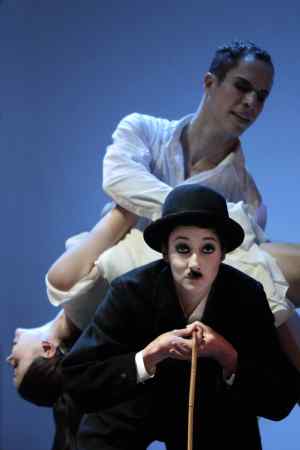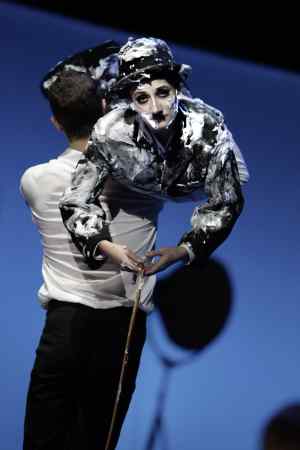Chaplin’s Little Tramp Speaks the Language of Dance
 Within the cultural exchange taking place on the occasion of the 40th anniversary of the artistic partnership between Leipzig and Brno, the Leipzig Ballet was invited to perform the piece Chaplin on the stage of the National Theatre Brno. The Brno ballet ensemble then gave guest performances in Leipzig, presenting the successful ballet Lucidor and Arabella by choreographer Youri Vàmos.
The Leipzig Ballet is currently one of the most successful companies, founded at the end of the 17th century. The early 1990s witnessed its artistic rise and growing prestige with Uwe Scholze assuming the position of the director and principal choreographer. After his death, it was Paul Chalmer who took the post and since the 2010/2011 season the company has been directed by Mario Schröder. Brno got acquainted with Schröder and his choreographic work in 2010 within the Tanzbrücke project featuring a shorter choreography Your Life and dance musical Love Hurts… Petrushka.
The ballet Chaplin is based on the actual biography of the world-renowned moviemaker. It focuses on his private as well as artistic life and follows his path from his difficult childhood, first professional engagement with the Fred Karno Company up to his dazzling Hollywood career and expulsion from the USA provoked by his “communist sympathies.” The ballet consists of sixteen stage images, each of them accompanied by corresponding music. The musical compositions form a collage in which various historical periods are represented by the best composers of the day: Richard Wagner, Benjamin Britten, John Adams, Alfred Schnittke plus Chaplin’s original movie soundtracks. The music characterises fittingly the situations and moods presented by this contemporary work.
Solo for Ballet Ensemble
The choreographic conception and approach to the topic rely on the versatility of the ballet ensemble. The exposition itself brings on stage a buoyant and dynamic group choreography which is childlike and playful and it uses all the attributes of the Tramp – his essential bowler hat, walking stick or baggy trousers. Another period of Chaplin’s life is marked by his performing with the Fred Karno Company. Here the authors had some space for humour, synchrony in the partnering, comic situations and especially for male acrobatic numbers inspired among others by contemporary break dance. Allusions to Chaplin’s Hollywood productions develop fully in a whole-ensemble slapstick-like dance which has the same atmosphere as Chaplin’s movies – laughter on the edge and the ability to tackle serious social problems thought slapstick comedy at the time when America is waltzing but Europe is in war. The stage full of tramps and their constantly repeating mechanic movements evoke Chaplin’s famous Modern Times. The dancers of the ballet ensemble - embodying the crowd - glorify Chaplin and carry him on their shoulders only to lynch him a few moments later.
Man and His Tramp
Within the cultural exchange taking place on the occasion of the 40th anniversary of the artistic partnership between Leipzig and Brno, the Leipzig Ballet was invited to perform the piece Chaplin on the stage of the National Theatre Brno. The Brno ballet ensemble then gave guest performances in Leipzig, presenting the successful ballet Lucidor and Arabella by choreographer Youri Vàmos.
The Leipzig Ballet is currently one of the most successful companies, founded at the end of the 17th century. The early 1990s witnessed its artistic rise and growing prestige with Uwe Scholze assuming the position of the director and principal choreographer. After his death, it was Paul Chalmer who took the post and since the 2010/2011 season the company has been directed by Mario Schröder. Brno got acquainted with Schröder and his choreographic work in 2010 within the Tanzbrücke project featuring a shorter choreography Your Life and dance musical Love Hurts… Petrushka.
The ballet Chaplin is based on the actual biography of the world-renowned moviemaker. It focuses on his private as well as artistic life and follows his path from his difficult childhood, first professional engagement with the Fred Karno Company up to his dazzling Hollywood career and expulsion from the USA provoked by his “communist sympathies.” The ballet consists of sixteen stage images, each of them accompanied by corresponding music. The musical compositions form a collage in which various historical periods are represented by the best composers of the day: Richard Wagner, Benjamin Britten, John Adams, Alfred Schnittke plus Chaplin’s original movie soundtracks. The music characterises fittingly the situations and moods presented by this contemporary work.
Solo for Ballet Ensemble
The choreographic conception and approach to the topic rely on the versatility of the ballet ensemble. The exposition itself brings on stage a buoyant and dynamic group choreography which is childlike and playful and it uses all the attributes of the Tramp – his essential bowler hat, walking stick or baggy trousers. Another period of Chaplin’s life is marked by his performing with the Fred Karno Company. Here the authors had some space for humour, synchrony in the partnering, comic situations and especially for male acrobatic numbers inspired among others by contemporary break dance. Allusions to Chaplin’s Hollywood productions develop fully in a whole-ensemble slapstick-like dance which has the same atmosphere as Chaplin’s movies – laughter on the edge and the ability to tackle serious social problems thought slapstick comedy at the time when America is waltzing but Europe is in war. The stage full of tramps and their constantly repeating mechanic movements evoke Chaplin’s famous Modern Times. The dancers of the ballet ensemble - embodying the crowd - glorify Chaplin and carry him on their shoulders only to lynch him a few moments later.
Man and His Tramp The choreographer split Charlie Chaplin’s stage personality ingeniously into two dance parts. There is a clear contrast between the artist-man and the character of the “Little Tramp” who was created by Chaplin just for the silver screen and through whom he expressed his visions, dreams and also anxieties. The role of Chaplin-artist was danced by the great Tyler Galster. He puts a lot of emotions into his performance and that works very well in lyrical passages – such as Chaplin’s first steps in show business or beautiful duets with the women of his life. The Little Tramp, symbolizing humanity in the ballet, is performed exquisitely by a female dancer – Amelia Waller. Her interpretation makes the role astoundingly frail and the interferences between the artist and his character are also very interesting. Amelia Waller’s Little Tramp - with his typical costume, oversized boots, turned-out feet, tiny steps and slightly swinging head – is moving. She does not only imitate Chaplin’s movements. She often joins the other dancers or comments, with the peculiar sense of humour, on the love duets which then turn into witty trios. Waller is incredibly flexible, sincere and real.
Total Theatre
Mario Schröder is not only a great choreographer but also a director able to tell the story while making use of contemporary dance language and thus creating real dance theatre. The performance goes hand by hand with its visual side. The sets, costumes and video projections were designed by Paul Zoller. They are simple but still clearly delivering the message. There are some memorable features like the “room” – a white open cube with a table and a chair mounted to the wall or the ceiling and serving as exercise equipment. The torn-off red curtain symbolises Chaplin’s mother’s death. The Hollywood movie studios are represented by large open space and lime lights - these are important at the very end of the show when they follow, for the last time, the leaving, limping Little Tramp. Another funny moment comes with the gallery of glamorous Hollywood stars bustling around in pink dressing gowns and turning their black-and-white-old-photo faces (masks on the dancers’ faces) to the audience. The final part of Chaplin, culminating in a witch-hunt scene, sees the white colour spreading from the hammer-and-sickle emblem and gradually covering the entire wall of the room and the Tramp’s costume. The last scene brings both catharsis and piece in finding a new love and also the Tramp’s moving farewell.
On its premiere in Leipzig, Chaplin was rewarded with frenetic applause and standing ovations. The same happened after the guest performance in Brno.
Written from the performance held on 19 January, 2014 in National Theatre Brno.
Chaplin
The choreographer split Charlie Chaplin’s stage personality ingeniously into two dance parts. There is a clear contrast between the artist-man and the character of the “Little Tramp” who was created by Chaplin just for the silver screen and through whom he expressed his visions, dreams and also anxieties. The role of Chaplin-artist was danced by the great Tyler Galster. He puts a lot of emotions into his performance and that works very well in lyrical passages – such as Chaplin’s first steps in show business or beautiful duets with the women of his life. The Little Tramp, symbolizing humanity in the ballet, is performed exquisitely by a female dancer – Amelia Waller. Her interpretation makes the role astoundingly frail and the interferences between the artist and his character are also very interesting. Amelia Waller’s Little Tramp - with his typical costume, oversized boots, turned-out feet, tiny steps and slightly swinging head – is moving. She does not only imitate Chaplin’s movements. She often joins the other dancers or comments, with the peculiar sense of humour, on the love duets which then turn into witty trios. Waller is incredibly flexible, sincere and real.
Total Theatre
Mario Schröder is not only a great choreographer but also a director able to tell the story while making use of contemporary dance language and thus creating real dance theatre. The performance goes hand by hand with its visual side. The sets, costumes and video projections were designed by Paul Zoller. They are simple but still clearly delivering the message. There are some memorable features like the “room” – a white open cube with a table and a chair mounted to the wall or the ceiling and serving as exercise equipment. The torn-off red curtain symbolises Chaplin’s mother’s death. The Hollywood movie studios are represented by large open space and lime lights - these are important at the very end of the show when they follow, for the last time, the leaving, limping Little Tramp. Another funny moment comes with the gallery of glamorous Hollywood stars bustling around in pink dressing gowns and turning their black-and-white-old-photo faces (masks on the dancers’ faces) to the audience. The final part of Chaplin, culminating in a witch-hunt scene, sees the white colour spreading from the hammer-and-sickle emblem and gradually covering the entire wall of the room and the Tramp’s costume. The last scene brings both catharsis and piece in finding a new love and also the Tramp’s moving farewell.
On its premiere in Leipzig, Chaplin was rewarded with frenetic applause and standing ovations. The same happened after the guest performance in Brno.
Written from the performance held on 19 January, 2014 in National Theatre Brno.
ChaplinChoreography: Mario Schröder
Conductor: William Lacey (reproduced music in Brno)
Sets, costumes and video: Paul Zoller
Dramaturgy: Thilo Reinhardt
Premiere: 2010 Translation: Tereza Cigánková


